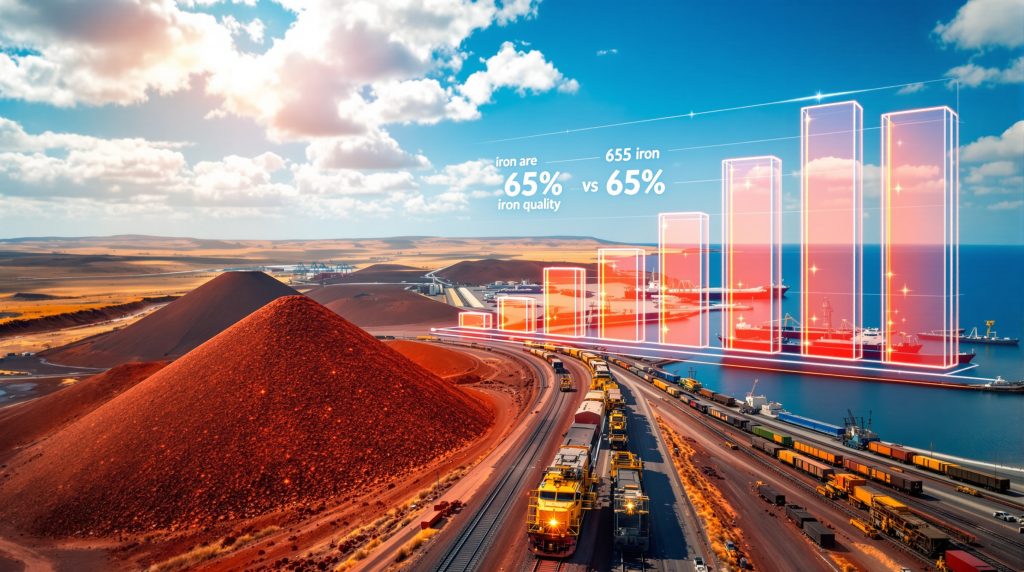What Makes Rio Tinto's Simandou Iron Ore Shipment Historically Significant?
Rio Tinto's first rio tinto simandou iron ore shipment from Guinea's Simandou project marks a pivotal transformation in global mining dynamics. The October 2025 loading of initial ore onto rail transport represents years of infrastructure development finally reaching commercial reality. This milestone introduces West Africa as a major player in seaborne iron ore markets previously dominated by Australian and Brazilian suppliers.
The project's significance extends beyond its massive scale potential. Industry experts anticipate substantial market disruption as Simandou's high-grade ore reaches international buyers. Tom Price from Panmure Liberum noted that iron ore price trends could face downward pressure if established miners fail to respond effectively to this new competition.
Revolutionary Infrastructure Achievement
The engineering accomplishment behind Simandou represents unprecedented logistical coordination. A 600-kilometer railway system connects inland deposits to deepwater port facilities on Guinea's Atlantic coast. This heavy-haul transportation network enables bulk commodity movement across diverse terrain, demonstrating how modern mining operations require comprehensive infrastructure solutions to unlock remote mineral wealth.
Furthermore, Rio Tinto's initial approach involves utilising port facilities owned by partner Winning Consortium Simandou, whose operations are nearing completion. This collaborative arrangement allows both mining ventures to begin exports while final infrastructure elements are finalised.
Market Impact Projections
The inaugural shipment heading to China signals the beginning of significant supply chain rebalancing. Peter Cunningham, Rio Tinto's finance chief, previously indicated that Simandou's market entry would likely force higher-cost suppliers to exit operations or dramatically improve efficiency. This competitive pressure could reshape pricing structures across the entire seaborne iron ore trade.
Market analysts project that once full capacity is reached, Simandou could contribute up to 8-9% additional supply to global seaborne markets, creating pricing volatility that benefits steel producers while challenging traditional mining operations.
How Does Simandou's Iron Ore Quality Compare to Global Standards?
Simandou's mineral composition delivers exceptional value propositions for steel manufacturers worldwide. The deposit contains ore averaging 65% iron content, significantly exceeding typical industry standards. This superior grade enables steel producers to reduce energy consumption during manufacturing processes while meeting increasingly stringent environmental regulations.
The estimated 4 billion tons of reserves at Simandou position the project among the top iron ore mines 2025 worldwide. This combination of quality and quantity creates long-term supply security for international buyers seeking premium ore specifications.
Superior Grade Advantages
| Quality Metric | Simandou | Industry Average |
|---|---|---|
| Iron Content | 65% | 58-62% |
| Reserve Estimate | 4 billion tons | Varies |
| Processing Benefits | Reduced energy requirements | Standard |
Steel Production Benefits
Higher iron content translates directly into operational cost reductions for steel manufacturers. Chinese steelmakers, facing margin pressures and prolonged property sector challenges, increasingly prioritise high-grade ores to improve energy efficiency and reduce carbon emissions. Simandou's specifications align perfectly with these industry requirements.
The superior ore quality enables steel producers to optimise blast furnace operations, reducing coke consumption and lowering overall production costs. These efficiency gains become particularly valuable as environmental regulations tighten across major steel-producing regions.
What Are the Key Production Milestones for Rio Tinto's Simandou Operations?
Rio Tinto's development timeline demonstrates systematic scaling from initial stockpiling through full commercial production. The carefully orchestrated phases minimise market disruption while maximising operational efficiency as production volumes increase.
Phase 1: Initial Stockpiling and Transport Testing
• October 2025: First ore successfully loaded onto rail transport system
• Mid-November 2025: Initial vessel loading expected at port facilities
• Stockpile Achievement: 2 million metric tons accumulated for inaugural shipment
• Infrastructure Utilisation: Temporary use of Winning Consortium Simandou port facilities
According to Rio Tinto's third-quarter production report, SimFer operations had accumulated 1.5 million tons, with additional stockpiling pushing total volumes to 2 million tons for the first shipment.
Phase 2: Production Ramp-Up Schedule
• Full Capacity Goal: 120 million tons annually across entire Simandou complex
• SimFer Contribution: 60 million tons per annum from SimFer operations
• Market Impact Timeline: Production scaling expected through 2028
The phased approach allows operational teams to optimise transportation logistics and port handling capabilities before reaching maximum production volumes. This systematic scaling reduces technical risks while building market confidence in consistent supply delivery.
Why Is China the Primary Destination for Simandou Iron Ore?
China's steel industry consumes over 70% of global seaborne iron ore, making it the natural primary market for Simandou's premium ore. The inaugural shipment's destination reflects China's dominant position in international steel production and its growing preference for high-grade materials.
Chinese steelmakers face mounting pressure from margin compression and a prolonged property downturn, driving demand for cost-effective, high-grade ore that reduces energy consumption and emissions. Simandou's 65% iron content directly addresses these operational requirements.
Strategic Supply Chain Positioning
Atlantic routing provides Chinese importers with supply chain diversification, reducing dependence on Pacific Basin sources while potentially offering freight cost advantages through alternative shipping routes. This geographic diversification strengthens supply security for Chinese steel producers.
The timing of Simandou's market entry aligns with China's tightening influence over Guinea's resource sector. Chinese involvement in bauxite exports has already established strong bilateral trade relationships, creating favourable conditions for iron ore commerce.
Quality-Driven Demand
Chinese steel producers increasingly prioritise high-grade ores to improve energy efficiency and reduce carbon emissions. Environmental regulations and operational cost pressures drive this preference for premium materials that optimise blast furnace performance.
Simandou's superior iron content enables Chinese steelmakers to reduce coke consumption and lower energy costs while maintaining production volumes. These efficiency gains become critical as the industry navigates environmental compliance requirements and margin pressures.
How Will Simandou Impact Global Iron Ore Pricing Dynamics?
Market analysts anticipate significant pricing pressures as Simandou reaches full production capacity. The project's potential to contribute 120 million tons annually represents a substantial addition to global seaborne supply, forcing higher-cost producers to optimise operations or exit markets entirely.
Supply Increase Calculations
• Market Share Impact: 8-9% increase in seaborne supply at full capacity
• Annual Contribution: 120 million tons across entire Simandou complex
• Timeline: Production scaling expected through 2028
Tom Price of Panmure Liberum emphasised that Australian and Brazilian miners must respond strategically to Simandou's ramp-up to avoid downward pricing pressure. This competitive dynamic could force industry consolidation or operational improvements among established suppliers, particularly considering ongoing iron ore price decline concerns.
Competitive Response Scenarios
Established producers face several strategic options as Simandou enters markets. Operational efficiency improvements, cost reduction initiatives, or strategic consolidation may become necessary to maintain market position against Simandou's competitive advantages.
Peter Cunningham's assessment that higher-cost suppliers will likely exit markets reflects the fundamental shift toward premium ore sources that offer superior processing economics. This market evolution favours high-grade deposits while challenging marginal operations.
What Infrastructure Innovations Enable Simandou's Success?
The project's infrastructure represents cutting-edge mining logistics, combining heavy-haul railway technology with deepwater port facilities specifically designed for high-volume iron ore exports. This comprehensive transportation system unlocks previously inaccessible mineral wealth through innovative engineering solutions.
Railway System Specifications
• Total Length: 600 kilometres connecting mine to port facilities
• Capacity Design: Support for 120+ million tons annually at full operation
• Geographic Challenge: Traverses diverse terrain from inland deposits to coastal facilities
• Technology Integration: Heavy-haul locomotives and specialised ore transport cars
The railway system's design accommodates the massive volumes required for economic viability while managing challenging topographical conditions. This infrastructure investment demonstrates how modern mining enterprises overcome geographic barriers through comprehensive logistical planning.
Port Facility Development
The deepwater port construction enables accommodation of large bulk carriers, optimising shipping economics for long-distance transport to Asian markets. The facility's design specifications support high-volume loading operations required for efficient ore export.
Initial exports utilise Winning Consortium Simandou port infrastructure, creating collaborative arrangements that benefit both mining operations while final facilities reach completion. This partnership approach maximises infrastructure utilisation during the critical market entry phase.
How Does Simandou Benefit Guinea's Economic Development?
The International Monetary Fund projects that Simandou operations will boost Guinea's GDP by 26% by 2030, demonstrating the transformative economic impact of large-scale mining developments on host countries. This substantial contribution reflects the project's scale and integration with Guinea's broader economic development objectives.
Guinea's military government plans formal project commissioning on November 11, 2025, highlighting the strategic importance placed on Simandou's successful launch. Government involvement ensures regulatory support while maximising national economic benefits.
Direct Economic Contributions
• Employment Generation: Substantial direct and indirect job creation across mining operations
• Government Revenue: Significant royalty and tax income from production activities
• Infrastructure Development: Railway and port facilities supporting broader economic activity
• Skills Transfer: Technical expertise development within local workforce
The project's economic impact extends beyond direct mining activities. Infrastructure investments create foundations for additional industries and services, potentially attracting complementary economic development to Guinea's evolving economy.
Regional Development Catalyst
Simandou's infrastructure investments establish foundations for broader economic activities that extend beyond mining operations. The railway and port facilities could support agricultural exports, manufacturing development, and regional trade expansion.
China's tightening involvement in Guinea's resource sector, building on established bauxite export relationships, creates additional opportunities for bilateral economic cooperation and investment in complementary industries.
What Challenges Could Affect Simandou's Production Trajectory?
Despite promising initial developments, several factors could influence Simandou's ability to achieve full production targets and maintain consistent operations. Understanding these potential challenges helps assess long-term project viability and market impact.
Operational Risk Factors
• Infrastructure Reliability: Railway and port system performance under full capacity operations
• Weather Dependencies: Seasonal impacts on transportation and loading operations
• Technical Complexity: Managing high-volume operations across extensive supply chain
• Market Volatility: Iron ore price fluctuations affecting project economics
The project's reliance on complex infrastructure systems creates potential vulnerability to technical disruptions or capacity constraints. Maintaining consistent operations across 600 kilometres of railway and coordinated port activities requires sophisticated operational management.
Geopolitical Considerations
Guinea's political stability and regulatory environment significantly influence long-term operational success and international investor confidence. The current military government's support provides immediate stability, but political transitions could affect operational continuity.
Regional security conditions and international relations may impact transportation routes and export logistics. Maintaining stable operating conditions requires ongoing diplomatic and security coordination across multiple stakeholders.
How Do Joint Venture Partnerships Shape Simandou's Development?
The complex ownership structure involving Rio Tinto, Chinese partners, and Guinea's government creates both opportunities and challenges for project management and strategic decision-making. These partnerships enable risk sharing while requiring coordinated management across multiple entities.
SimFer Joint Venture Structure
Simandou ownership involves a consortium arrangement between Rio Tinto and Chinese state-owned Chalco, working alongside the Winning Consortium Simandou partnership. This structure enables shared investment while distributing technical expertise across complementary operations.
SimFer operations target contributing 60 million tons annually to the total 120 million ton capacity across the entire Simandou complex. This production allocation reflects operational capabilities and infrastructure access arrangements between joint venture partners.
Winning Consortium Simandou Collaboration
The parallel development of adjacent blocks by the Singaporean-Chinese consortium creates competitive dynamics while enabling shared infrastructure utilisation during initial production phases. Both operations began stockpiling activities in late 2025, establishing early market positioning.
This collaborative competition benefits overall project development by accelerating infrastructure completion and operational optimisation. Shared resources and coordinated logistics reduce individual investment requirements while maximising collective efficiency.
What Long-Term Market Implications Follow Simandou's Launch?
Simandou's entry into global iron ore markets signals a fundamental shift toward supply source diversification, potentially reducing market concentration while introducing competitive dynamics that benefit steel producers. This transformation extends beyond immediate pricing effects.
Supply Chain Resilience
Geographic diversification strengthens global steel industry supply chain resilience, reducing vulnerability to disruptions affecting traditional major suppliers in Australia and Brazil. Atlantic routing provides alternative logistics pathways for Asian importers.
The additional supply source creates buffer capacity during market disruptions while offering steel producers enhanced negotiating leverage with established suppliers. This competitive environment encourages operational efficiency improvements across the entire industry.
Innovation Catalyst
Simandou's successful infrastructure development demonstrates viable approaches for unlocking remote, high-grade deposits worldwide. The project's engineering solutions could accelerate technological advancement in mining logistics and transportation systems.
Other developing regions with similar mineral resources may adopt comparable development strategies, potentially creating additional competition for established mining operations while expanding global supply diversity. However, this increased competition must be considered alongside ongoing iron ore demand insights and potential market dynamics affecting resource allocation.
Furthermore, the success of Simandou may intensify the ongoing iron ore asset battle among major mining companies seeking to secure strategic positions in high-grade ore markets.
Investment and Market Considerations
This analysis involves market projections and economic forecasts that carry inherent uncertainties. Commodity markets experience significant volatility, and actual outcomes may differ from projected scenarios. Investors should conduct independent research and consider multiple factors before making investment decisions related to iron ore markets or mining operations.
Simandou's strategic significance for global mining extends beyond introducing new supply capacity. The project demonstrates how comprehensive infrastructure investment and international partnerships can unlock previously inaccessible mineral wealth while reshaping established market dynamics.
The successful launch positions West Africa as a critical supplier for international steel production while providing geographic diversification that enhances supply chain resilience. As production scales toward full capacity, Simandou will likely influence competitive strategies across the global iron ore industry.
For steel producers worldwide, the project offers supply diversification opportunities alongside access to premium ore grades that support operational efficiency and environmental compliance objectives. Long-term success depends on maintaining operational excellence while navigating complex international market dynamics and evolving geopolitical considerations.
Ready to Capitalise on the Next Major Mineral Discovery?
Discovery Alert instantly alerts investors to significant ASX mineral discoveries using its proprietary Discovery IQ model, turning complex mineral data into actionable insights. Understand why major mineral discoveries can lead to substantial market returns by exploring Discovery Alert's dedicated discoveries page, showcasing historic examples of exceptional outcomes, and begin your 30-day free trial today to position yourself ahead of the market.




